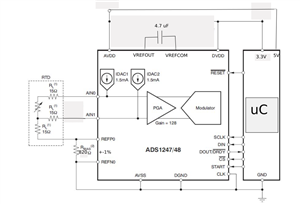Hi,
Does anyone know what could be the cause of unstable last 2 bytes from 24bits RTD temperature reading. The first MSB from 24bits is stable and the other two bytes (Mid and LSB) change values rapidly(can be seen on an osciloscope).
My set up is similar to TI 3-Wire RTD Measurement System Reference Design document but more basic and modest, i.e no decupling capacitors (only one between Vrefout and Vrefcom), no low pass filter on Vref. Other config details :
Sensor: PT100
Rref: 820ohms
Idac = 1mA
Vref = 1,64V
Gain = 4
Data rate = 1000SPS
clock used: internal
mode: continuous
calibration: none



